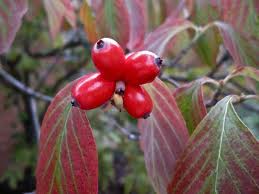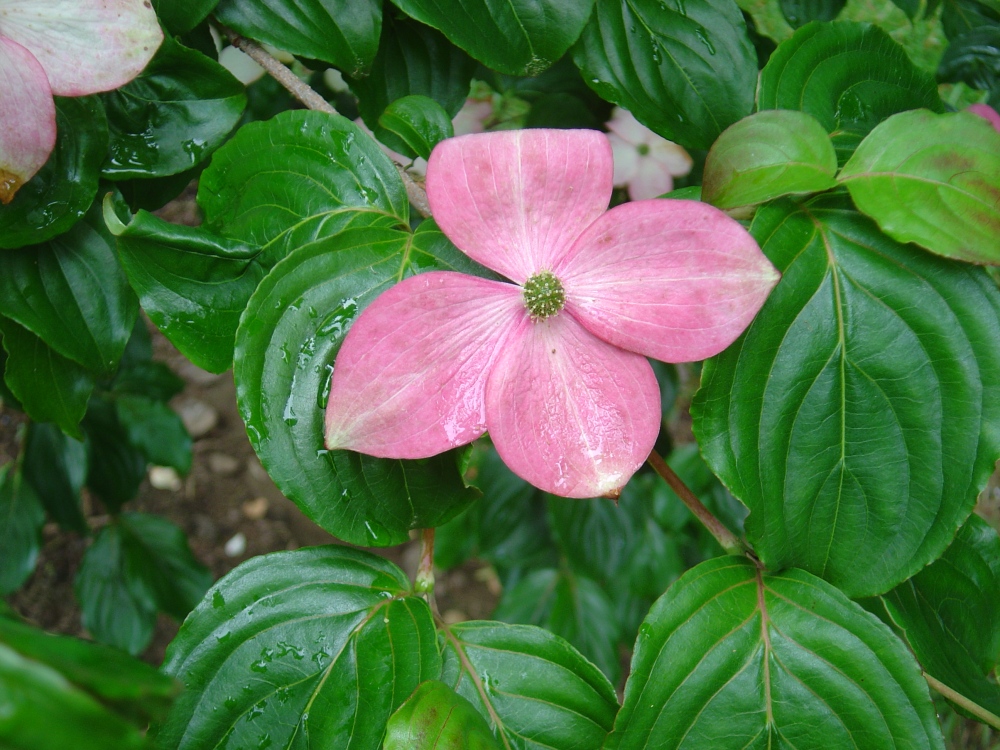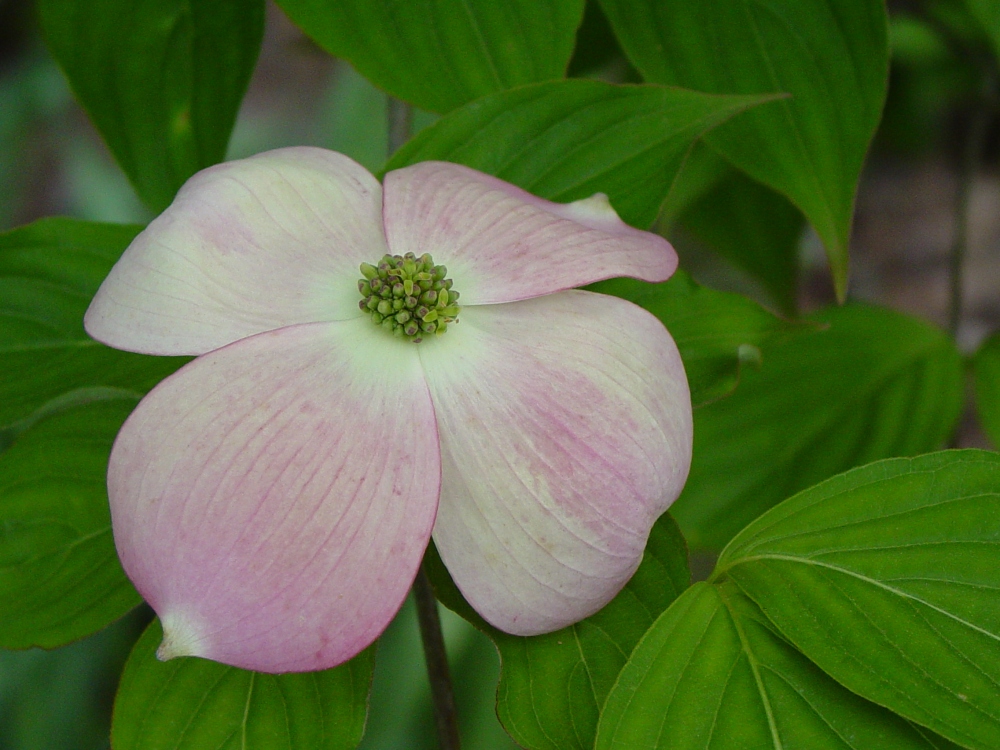Through the years I have planted a handful of native dogwoods (Cornus florida) in my garden, and each year I am overwhelmed by their incomparable beauty. White blooms arrive on bare branches by mid April, followed by lush, medium green foliage, clusters of red berries in late summer, and leaves that turn to a brilliant red in September and persist into early autumn. The berries are favored by neighborhood birds, who quickly strip them so that the deeply furrowed gray bark is the lone ornament of winter.
With adequate space dogwoods grow slightly wider than tall (to twenty feet or so), though nursery grown trees will initially appear more upright in habit. They are understory trees, naturally growing below the taller forest canopy, but will often be found in abundance beside redbuds clustered at the forest’s edge. Seedling dogwoods that pop up in shady wooded areas will stretch for sunlight, and will not exhibit the compact branching found in trees growing in partial to full sun.

The native dogwood can be a bit troublesome in transplanting, and attempts to dig seedlings usually end in failure. Nursery grown trees are more dependable, but care must be taken to select trees with firm rootballs since loose or broken roots will often result in a tree that struggles for survival.
Dogwoods respond poorly to container growing, so they are usually grown in the ground and dug with a burlap covering. Larger trees will be enclosed in a heavy wire basket, which ideally is removed with heavy duty metal snips so that the roots are not disturbed. The burlap need not be removed, but the top covering should be removed or cut off so that the burlap does not shed water.
Dogwoods are very particular about the depth of the planting hole, and will fail if planted too low, or in poorly drained soils. Best practice is to dig a hole twice the width of the rootball, but slightly shallower so that the top of the rootball is a couple inches above the surrounding ground. If you must amend the excavated soil with topsoil or compost, do so sparingly (and mix thoroughly with exiting soil, no matter how poor you believe your soil is) for there is danger that richly organic soils will retain too much moisture and damage the dogwood’s roots.
The white flowering dogwoods in my garden are cultivars that have been selected for improved blooming, or for more rapid growth, but most popularly found cultivars are grown for their vigorous growth and resistance to the range of diseases that are common to native dogwoods. The most common dogwood problem is a fungal black spotting that can be disfiguring, or even fatal, but dogwoods are also susceptible to powdery mildew and borers.
In my garden I have not had severe problems with native dogwoods that I have planted, though one tree labeled as pink proved to be white flowering. In a rainy spring there will be some black spotting and a little powdery mildew, even on the highly resistant ‘Cherokee Princess’. The red flowering, variegated leaf ‘Cherokee Sunset’ (above) is most prone to disease, and it grows much more slowly because its foliage is partially covered with mildew each spring. I don’t spray to prevent or remedy these issues, and find that fungicides are rarely needed for these temporary conditions, but if you’re concerned that the native dogwood might not be a long lived tree for your garden there are superb alternatives.
Chinese dogwoods (Cornus kousa, above) are sturdy, low branched, almost shrub-like trees, that bloom late in the spring (after the tree has leafed), and with excellent resistance to disease. In my garden there are a number of lovely Chinese dogwoods with white blooms in late May into June, and ‘Satomi’ (below) with pink flowers, though the pink will be faded if temperatures have been warm or rainfall lacking.

‘Wolf Eyes’ (below) is wide spreading with green and white variegated foliage and white blooms, and ‘Samaritan’ is a more vigorous variegated leaf dogwood with an upright form. Both variegated forms are superb trees for the small garden.
These are dependable bloomers with long lasting flowers that will almost cover the lustrous dark green foliage, and to my thinking they are underutilized in gardens. Their beauty and pest resistance should earn them a more prominent presence, but they take a back seat to the American native. In recent years hybrids between Cornus florida and Cornus kousa have been introduced by Dr. Elwin Orton of Rutgers University that flower a few weeks later than the native dogwoods, but also a few weeks earlier than the Chinese dogwoods. Their habit is more upright and more vigorous than the Chinese dogwoods, and they have proven to be very resistant to dogwoods’ typical maladies.
In my garden ‘Stellar Pink’ (above) grows rapidly in partial sunlight, blooms heavily (though not in its early years), and its leaves are completely free of black spot and mildew so that the foliage looks spring-fresh in the heat of summer. The pink blooms are faded by early heat and lack of rainfall much like the Satomi Chinese dogwood, but with only a blush of pink the flowers are delightful.

More recent Rutgers introductions have featured crosses between the Pacific dogwood (Cornus nuttali) and the Chinese dogwood, and the resulting trees are vigorous, disease resistant growers with huge white flowers that form with the leaves. The ‘Venus’ dogwoods (above) in my garden are young, but the six inch diameter blooms are so large that they are out of scale for the small trees. With growth of a few years I am certain that these will be among my favorite trees, and so if you are looking for an alternative to our native dogwood I encourage you to consider ‘Venus’ and the similar ‘Starlight’.
Planting time is here, and if you have space enough for a small tree then one dogwood or the other should be on your list of “must-have” trees to plant.
Dave, I absolutely LOVE your yard/garden!!! Glad I’m not the only plant freak out there!
This past weekend I was at a party and their dogwood was in full bloom. It looked exactly like the Starlight except it had pink edging on the bloom. Does anyone know what the variety would be?
‘Stellar Pink’ typically has white flowers with a blush of pink, with a higher concentration of color along the margins. The flowers are not quite as large as on ‘Starlight’ but they’re close enough that I suspect this is the tree you saw.